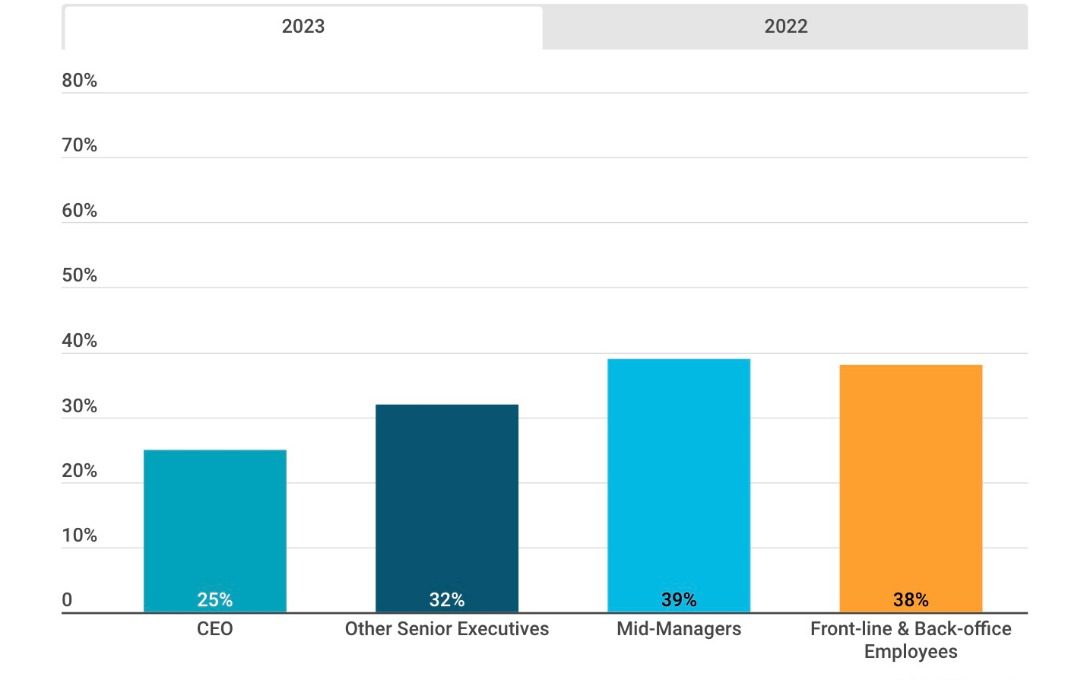CEO Survey: Bonuses Will Take A Hit In 2023


According to data from our CEO & Senior Executive Compensation Report for Private U.S. Companies, 2021 bonus payouts were historically high—especially following the Covid cutbacks. Bonuses 2022 followed suit for many, as growth out of the pandemic continued. Will 2023 fit the trend? Preliminary data says no.
A recent poll of 333 CEOs in the U.S., conducted January 10-12 by Chief Executive, finds bonuses among almost every class of worker are likely to dwindle in 2023, a sudden shift from recent trends. Compared to 2022, smaller proportions of workers in all seniority levels are projected to see bonus increases, with companies instead opting to keep the payout unchanged or even decreased.
The survey is part of ongoing compensation research by Chief Executive Group, which includes our annual CEO and Senior Executive Compensation report, the largest survey of its kind conduced in the United States. It includes pay information from more than 1,800 U.S. companies. Learn more about our compensation benchmarking research >
Salary raises are also expected to stall this year, our research finds, but 2023 bonuses will fall even more. Some 20 percent of senior executives (not CEOs) are projected to see a weaker bonus this year, compared to only 7 percent who saw their bonus fall in 2022. Similarly, only 15 percent are projected to see an increase in their bonus of 5 percent or more, compared to 27 percent who earned the extra bonus last year.
Middle managers, front-line and back-office employees are likely to be the most disappointed—the proportion of those job categories receiving a bonus increase of at least 5 percent is projected to fall by more than half, down from 32 percent in 2022 to a projected 14 percent in 2023, across both levels.
As for CEOs, just 9 percent of companies reported a decrease in bonus for their CEO in 2022. When polled this month, 24 percent report a projected bonus drop. The already-small proportion of CEOs who received at least a 5 percent boost to their bonus is projected to shrink from 21 percent last year to 12 percent this year.
Click here for more information and additional breakdowns by industry, size, EBITDA, region and more.
Chief Executive Group exists to improve the performance of U.S. CEOs, senior executives and public-company directors, helping you grow your companies, build your communities and strengthen society. Learn more at chiefexecutivegroup.com.
0

1:00 - 5:00 pm
Over 70% of Executives Surveyed Agree: Many Strategic Planning Efforts Lack Systematic Approach Tips for Enhancing Your Strategic Planning Process
Executives expressed frustration with their current strategic planning process. Issues include:
Steve Rutan and Denise Harrison have put together an afternoon workshop that will provide the tools you need to address these concerns. They have worked with hundreds of executives to develop a systematic approach that will enable your team to make better decisions during strategic planning. Steve and Denise will walk you through exercises for prioritizing your lists and steps that will reset and reinvigorate your process. This will be a hands-on workshop that will enable you to think about your business as you use the tools that are being presented. If you are ready for a Strategic Planning tune-up, select this workshop in your registration form. The additional fee of $695 will be added to your total.

2:00 - 5:00 pm
Female leaders face the same issues all leaders do, but they often face additional challenges too. In this peer session, we will facilitate a discussion of best practices and how to overcome common barriers to help women leaders be more effective within and outside their organizations.
Limited space available.

10:30 - 5:00 pm
General’s Retreat at Hermitage Golf Course
Sponsored by UBS
General’s Retreat, built in 1986 with architect Gary Roger Baird, has been voted the “Best Golf Course in Nashville” and is a “must play” when visiting the Nashville, Tennessee area. With the beautiful setting along the Cumberland River, golfers of all capabilities will thoroughly enjoy the golf, scenery and hospitality.
The golf outing fee includes transportation to and from the hotel, greens/cart fees, use of practice facilities, and boxed lunch. The bus will leave the hotel at 10:30 am for a noon shotgun start and return to the hotel after the cocktail reception following the completion of the round.